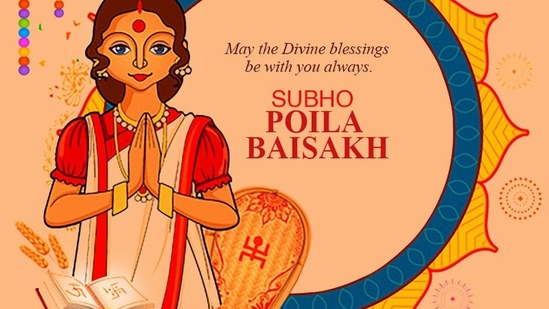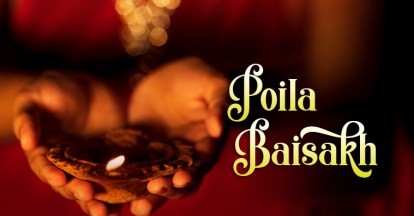| BENGALI NEW YEAR | |||
|---|---|---|---|
|
Pohela Boishakh (Bengali: পহেলা বৈশাখ) is the Bengali New Year celebrated on 14 April in Bangladesh and 15 April in the Indian states of West Bengal, Tripura, Jharkhand and Assam (Goalpara and Barak Valley). It is a festival based on the spring harvest—which marks the first day of the new year in the official calendar of Bangladesh.
The Pohela Boishakh has its origins in the Mughal Empire, representing the proclamation of tax collection reforms under Akbar. Its celebration is rooted in the traditions of the Mahifarash community of Old Dhaka.Presently, it is largely a secular holiday for most celebrants and enjoyed by people of several different faiths and backgrounds. The festival is celebrated with processions, fairs and family time. The traditional greeting for Bengalis in the new year is শুভ নববর্ষ "Shubho Noboborsho" which is literally "Happy New Year". The festive Mangal Shobhajatra is organised in Bangladesh. In 2016, the UNESCO declared this festivity organised by the Faculty of Fine Arts, University of Dhaka as a cultural heritage of humanity |
 |
||
|
বাঙালির নববর্ষের ঐতিহ্য
According to Shamsuzzaman Khan, and Nitish Sengupta, the origin of the Bengali calendar is unclear. According to Shamsuzzaman, it is called Bangla shon or shaal, which are Arabic (سن) and Persian (سال) words respectively, suggests that it was introduced by a Muslim king or sultan."In contrast, according to Sengupta, its traditional name is Bangabda. It is also unclear, whether it was adopted by Alauddin Husain Shah or Akbar. The tradition to use the Bengali calendar may have been started by Husain Shah before Akbar. Regardless of who adopted the Bengali calendar and the new year, states Sengupta, it helped collect land taxes after the spring harvest based on traditional Bengali calendar, because the Islamic Hijri calendar created administrative difficulties in setting the collection date. In Bangladesh however, the old Bengali calendar was modified in 1966 by a committee headed by Muhammad Shahidullah, making the first five months 31 days long, rest 30 days each, with the month of Falgun adjusted to 31 days in every leap year. This was officially adopted by Bangladesh in 1987. Since then, the national calendar starts with and the new year festival always falls on 14 April in Bangladesh.In 2018–19, the calendar was amended again, with Falgun now lasting 29 days in regular years and to 30 days in leap ones, in an effort to more align with Western use of the Gregorian calendar. However, the date of the celebration, 14 April, was retained. The Bengali calendar in India remains tied to the Hindu calendar system and is used to set the various Bengali Hindu festivals. For Bengalis of West Bengal and other Indian states, the festival falls either on 14 or 15 April every year. The current Bengali calendar in use in the Indian states is based on the Sanskrit text Surya Siddhanta. It retains the historic Sanskrit names of the months, with the first month as Baishakh. নববর্ষের রীতি ও সংস্কৃতি During Pohela Boishakh, people wear traditional attire, namely women clad in saris and salwar kameez and men dressed in kurta , visit their families and friends and spend time together. Pohela Boishakh is also known for uniting friends and family after a long time. It is a time for unity and reuniting, and spending enjoyable time with friends and family, while putting the past behind. Haal Khata is a festival celebrated on the occasion of Pohela Boishakh in order to complete all the account reckonings of the last year and open a new ledger. It is observed by the Bengali businessmen, shopkeepers and traders. It signifies that every year starts with a new beginning. It ignores all the due debts of customers and shopkeepers alike, and instead opens a new page for a new year of shopkeeping. On this occasion, males are seen wearing red or white Kurta with traditional designs on them, imprinted or embroidered. Women and young ladies wear red and white saree with blouses and put on flower crowns on their heads. Girls also dress in salwar kameez. They are seen wearing traditional ornaments and accessories along with their dresses. It is thought that it is because the traditional ledgers used in Haal Khata had a red cover with white pages. In recent times, claiming it to be traditional, Bengalis eat Panta Bhat or poitabhat, which is a rice-based dish prepared by soaking rice, generally leftovers, in water overnight. It is popularly eaten with Hilsa Fish and other curries.But many argue that it is not an age-old tradition and merely a trend. To stop overfishing and to repopulate the dwindling Hilsa population, around this time, fishing is banned. |
|||
 |
 |
 |
 |
| HOME | |||